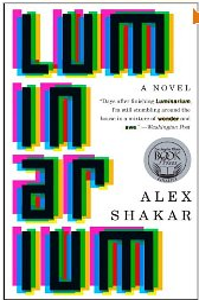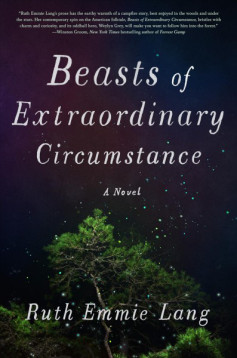In commenting on the solar system family photo taken by Voyager 1, Carl Sagan referred to the “blue dot” as home to every human who has ever lived. Now, we’re looking at potential lots on Mars, and using real cash for virtual reality property. LUMINARIUM explores computer generated virtual reality as well as the different realities created by the brain itself.
LUMINARIUM is the second novel by Alex Shakar. His first novel, THE SAVAGE GIRL, a fantasy about Pop Culture, was a New York Times Notable Book.
LUMINARIUM begins in the New York of August 2006. Protagonist Fred Brounian sits in a black vinyl recliner as someone attaches wires to a helmet that he’s wearing. Fred is a paid lab rat, part of an experiment by neuro-scientists at NYU. Several sessions have him wearing the helmet. Each session will stimulate a different part of his brain. The aim, the attractive researcher explains, is for Fred to experience an after-death “Rapture,” without the death part. The goal is to induce the “God” experience, freeing the subject from the “ignorance” of faith.
Fred, a thirty-something software designer, needs the money. Fred is paying for the hospital care of his identical twin brother and business partner George.
George, whose cancer has nearly consumed him, has been in a coma for months. George and Fred were CEO partners of a software company whose virtual reality program “Urth” “an anime style world of pastoral villages and underwater bubble towns…” should have made them rich. A “best laid plan,” it falls apart when 911 happens. Slick operators steal the company. Quirky little Urth belongs to Armation, a military enterprise in Florida, where “a ready pool of Disney Imagineers, Pixar animators, and Electronic Arts programmers” convert Urth into a military simulations program. George wanted to start over and create a game of “spiritual evolution.” Fred accused him of thinking “reality was up for grabs.”
Sam, George and Fred’s younger brother, is an executive in the new Armation order, and is helping the move to Florida. Sam suggested that Urth software would be useful in simulating urban disaster search and rescue. Sam’s need for control is right out of the Steve Jobs playbook. His social skills make Jobs look like Bill Clinton.
There have been glitches in the new search and rescue program, and a suggestion of sabotage. Fred is the most likely suspect. He and George saw their company stolen and their work compromised. There were hard feelings, but Fred needs his old job back. Fred’s first lab rat session results in a hyper-awareness that causes him to shadow an old woman in pin-curls, who meanders into a store and shoplifts. This results in his arrest for shoplifting tweezers. That’s right, tweezers. In addition, Fred receives emails from comatose George, a situation that threatens his already tentative hold on reality. As Fred struggles to regain stability in his life, the disorientation caused by the lab experiments, and more messages from George, result in him questioning his sanity. He wonders if someone is playing a cruel joke.
Fred is surrounded by illusion and mysticism. His father is an actor and a magician. Fred’s mother practices Reiki, a Japanese brand of energy healing. Mom believes that George emanates a healing energy from his hospital bed. As Fred tries to make sense of his expanded senses, the product, we assume, of the lab experiments, we, along with Fred, have difficulty sorting out reality. Shakar’s use of stream-of-consciousness in these sequences reminded me of the movie Altered States with a swirl (the old woman’s pin curls, “this infinite pinwheel of shit,” “The spiral had twisted shut again…”) of the senses that blurs the lines between different realities.
The cryptic emails from George contain the word “avatara.” Researching Hinduism, Fred discovers identical twin avataras, Nara and Narayana, who represent the human and the divine. The concept of “duality” is used throughout the novel. Fred clings to his identical twin. He reads stories to George about simultaneous twin occurrences, which “according to Carl Jung are …the dual manifestation of a single collective unconscious.” Fred questions how to “stand the two-sided coin on edge“– experiencing the divine, the supernatural, never able to verify. Is existence the result of some cosmic plan or is everything random?
Under all of this searching for alternate realities and the exploration of religions is the fear of death. Calendar pages mark dates leading to the fifth anniversary of the loss of the Trade Center Twin Towers. The enormity of this event permeates LUMINARIUM. Fred contemplates death, but can’t imagine not being somewhere. New York copes, but is forever changed. Fred faces a future where he is no longer a twin.
Creating different realities is a way of coming to terms with death. Besides the programs of various virtual worlds, Shakar takes us to a Florida mini-golf course , which is a virtual world modeled on pre-911 New York. Armation Florida employees live in the planned community “Celebration,” designed for controlled reality. Pre-fab reality is predictable and as safe as the womb. Sam yearns for it; Fred is both attracted and repelled.
George coins the word “holomelancholia…the inevitable disappointment of virtual worlds.” This concept fascinates me. I wrote my second book (currently in revisions) in response to Kurzweil’s prediction of the utopias that await us via mind-uploading. In Bali Hai, the “post-biological destination” setting of my novel Tales From Babylon Dreams, everything is perfect but the past. Through mind-uploading, we can escape death, but we can’t escape ourselves. Our bodies wear out, but can the human spirit live on indefinitely? One thing that makes life worth living is the luck of the draw, the chance that dreams can be realized or taken away. As Eric Packer, the protagonist of Cosmopolis (see my film review) did, I think eventually, we would all choose the “void.”
In his letter to readers, Shakar puts it this way: “How do we deal with a changed world, with a universe that one day seemed with us and the next seems to turn against us and oppose us at every turn?”
LUMINARIUM is the third literary novel that I have reviewed at length on this blog. It is the first that I totally recommend. The stream of consciousness style is dense. The long paragraphs were a challenge to my short-attention span, but I kept on reading. There were a few places where I felt he was doing a research paper rather than telling a story, but not too many to lose my interest in what happens to Fred. In his comments on LUMINARIUM in the New York Times Sunday Book Review, Christopher R. Beha remarks, “This premise, however ingenious, might have yielded a schematic novel of ideas, if Shakar weren’t so committed to showing his readers a good time.” I feel that Shakar’s respect for his readers is reflected in this commitment to “show us a good time.” Shakar gives us a complete, heartfelt story. Telling a story well and entertaining readers should not be limited to genre writers. Along the way, Shakar looks for answers, but doesn’t claim success.
If mind-uploading happens before I face whatever waits on the other side of that coin, I would like to float around in a place like Shakar’s “Urth,” especially in one of those underwater bubble towns. Maybe I’ll find Ringo’s Octopus’ Garden.
Advertisements Share this:- More





